
Bali is one of the destinations not too far from my country, Thailand, that I find incredibly beautiful, and it is a place that many Thais like to visit each year. Bali is one of the 34 provinces of Indonesia. Many people may not know that the island of Bali is huge. If compared to Phuket island in Thailand, the size of Bali is more than ten times larger.
The unique characteristics of Bali that captivate people around the world to visit, apart from beautiful beaches, ancient temples, Balinese architecture, and arts such as Rumah Adat (native houses), Pura (Balinese shrine), Bale (pavilion), and Meru (tower similar to pagoda), are all beautiful and valuable that I want everyone to see for themselves at least once. Because I must say, the Balinese character is unique and distinct when compared to other provinces in Indonesia.
Getting Around in Bali
Traveling in Bali has various forms, and I have to say that most tourist attractions are quite far apart, driving from the first place to the second in hours. Plus, there’s almost no public transportation on Bali itself. I think the two best ways to travel in Bali, which work well for the tourists, are as follows:
1. Renting a private car with a driver
Renting a private car with a driver is another method I recommend because it’s comfortable, you have someone to drive for you, and it’s safer than renting a car or a motorcycle to drive on your own. Finding a car to rent with a driver is extremely easy, you can book directly from Klook.
2. Renting a car or a motorcycle to travel on your own
Another method is to rent a car to drive on your own, they offer both cars and motorcycles for rent, and you can choose to rent according to your own abilities. But if you ask me, I’d recommend renting a car to drive. The rental process is very easy. On this trip, when I rented a car to drive in Bali, As I am Thai, I just needed to show a Thai driving license, and that was it. The car rental company didn’t even ask for an international driving license. However, If you are from another country that is not from South East Asia, you may need an international driving permit (IDP).
Personally, I like renting a car to drive on my own because we can go wherever we want without having to worry about time constraints. Because if we rent a car with a driver and accidentally travel beyond the rental time, they will definitely charge extra fees.
But if anyone prefers to explore more adventurous, and doesn’t want to rent a car to drive, renting a motorcycle is another option that can be funnier and speed up your travel. But don’t forget about safety, most of the roads in Bali are small and some are very congested.
Bali Travel Plan
For those who are planning to visit Bali, I recommend planning your trip by zones, because each location in Bali is quite far apart and requires several hours of travel. Even when I came this time with a solid plan, in reality, we could only visit about 3 places in a day, which was already quite full. Therefore, when planning a trip, we need to divide the zones well, whether it is the southern zone, central (Ubud), or even the far-flung east so that we can make the most of our travel time. If you are ready, let’s go to Bali with me. This time, we’ll spend a full 6 days, covering temples, beaches, and the famous landmarks that I can assure you, you must visit when you come to Bali.
| Day | Bali Itinerary / Attractions |
| 1 | Ubud Zone (Central Bali) |
| 2 | North-East Bali Zone |
| 3 | West-Central Bali Zone |
| 4 | South Bali Zone (Uluwatu) |
| 5 | Nusa Penida อ่านรีวิวเต็ม คลิก
|
| 6 | Nusa Penida / Click to read full review
|
| ที่พัก | |
| ส่วนลด OTA |
Day 1 in Bali:
Sacred Monkey Forest Sanctuary
Let’s start the first day in the heart of Bali, in the Ubud district. Ubud is known as the center of art and culture in Bali. It is one of the most popular tourist spots with a large number of visitors. Ubud isn’t next to the sea but is surrounded by nature and forests that make this area shady as soon as we step into this district.
The first place I’m taking everyone to is the Sacred Monkey Forest Sanctuary, a forest within the Ubud wild monkey conservation area. It is a natural habitat and sacred place for the Balinese long-tailed monkey (Macaca fascicularis). Inside, there are 3 important temples: Pura Dalem Agung Padangtegal, Holy Water Temple, and Pura Prajapati. These are located amidst a rainforest with more than 100 species of trees.

The Sacred Monkey Forest Sanctuary conserves the area following the concept of Tri Hita Karana, a philosophy in Hindu religion. The word ‘Tri’ means ‘three’, ‘Hita’ means ‘happiness’ and ‘Karana’ means ’cause or action’. When these three words are combined, it means ‘three ways to achieve spiritual and physical well-being’. This concept helps in creating harmony between humans and God, humans and humans, and humans and their environment so they can coexist harmoniously.

To visit the Sacred Monkey Forest Sanctuary, we need to buy tickets first. We can buy it at the gate or online through Klook [Buy tickets through Klook here] The ticket price is 80,000 Rupiah. Then, we can enter the sacred forest to meet the monkeys. Along the walking path that stretches into the sacred forest, in addition to seeing the lush trees of various species, we will encounter various deity statues along with monkeys. It feels like we’re stepping into the Payon forest dungeon in the game Ragnarok or something like that (haha). And of course, we will meet a large number of local long-tailed monkeys (Macaca fascicularis). Balinese people believe that these monkey troops are as sacred as the buildings and temples in this forest.


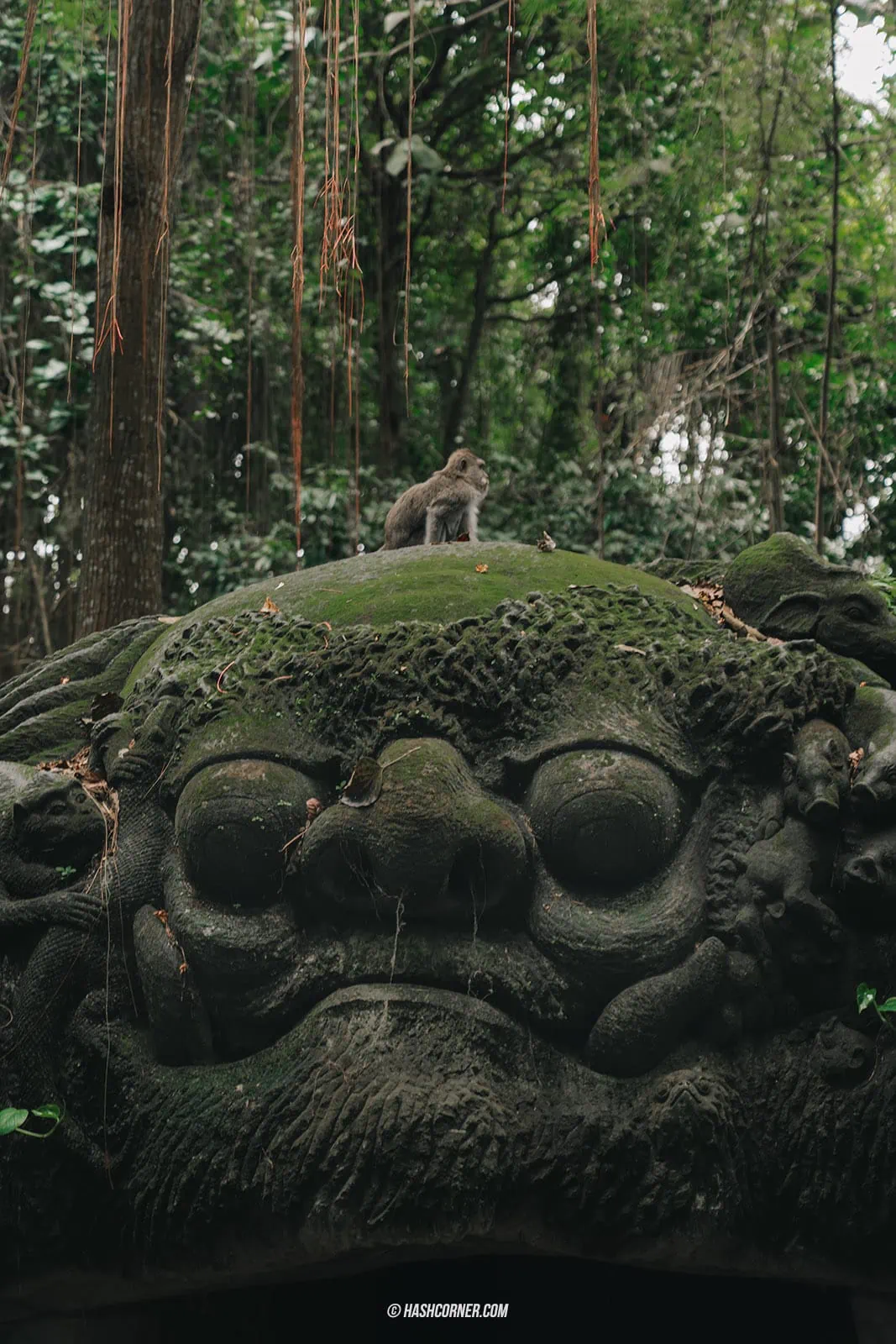



The three temples in the Sacred Monkey Forest Sanctuary were constructed back in the 14th century, about 600-700 years ago. The main one is the Dalem Agung Padangtegal temple, dedicated to Lord Shiva or Ishvara. Located in the southwestern direction, the temple isn’t generally accessible to tourists unless the locals wish to pray. Yet, the exterior is a sight to behold! An awe-inspiring Bali-styled temple laden with stone statues and verdant moss, all surrounded by dense forest. It gave an impression of walking through an enchanting game dungeon – I absolutely loved it!

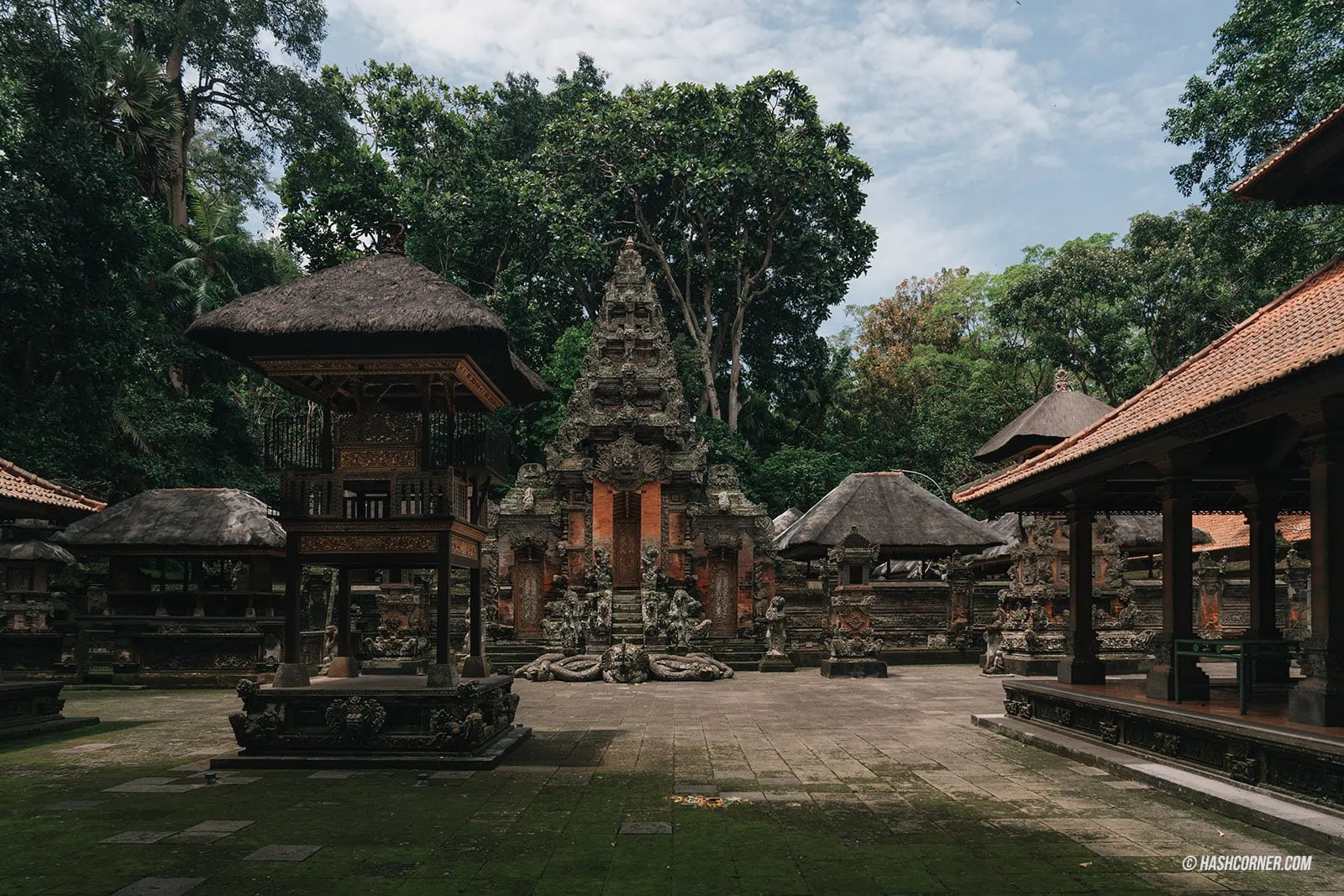


Next, we have the Pura Prajapati, or the Cremation temple, a favored spot to venerate Lord Brahma, the creator of the universe according to Hinduism. Finally, we have the Holy Water Temple, a popular destination to pay respects to the Goddess Kanga. This temple offers a different ambiance from the previous two. It features a pond adorned with a monkey statue in the middle, and it’s all encircled by walkways. The locals believe that the monkey carvings in the forest symbolize the power that sustains the temples.



Of course, the highlight of the Sacred Monkey Forest Sanctuary is the opportunity to interact with numerous monkeys scattered throughout the forest. These creatures, whether they’re lounging in groups, sprawling lazily, or simply observing the passing tourists, add a unique charm. The lush rainforest, abundant with diverse tree species, is also worth exploring. The cool, verdant expanse exudes a powerful aura, complimented by the Bali-style temples and towering trees, some over 100 years old. It’s got the distinctive allure of Bali!




In essence, the Sanctuary is a must-visit if you’re in Bali. You would not only get a sense of the place’s history and spirituality but also get to enjoy its natural beauty and playful monkey inhabitants. All these elements combined make the Sanctuary a very special place. I highly recommend you pay a visit at least once when you’re in Bali!
TIS Restaurant
Our original plan was to visit the famous Tegalalang Rice Terrace in Ubud, but the heavy rainfall on the day of our visit made it very challenging to navigate the steep, muddy paths of the rice terrace. Instead, we decided to chill out at a nearby cafe, the TIS Restaurant. This chic eatery with Balinese decor and ambiance boasts a stunning view of the Tegalalang Rice Terrace, allowing you to appreciate the lush green fields without having to trek down into the terraces themselves. Taking pictures and soaking up the view here was a joyous experience.

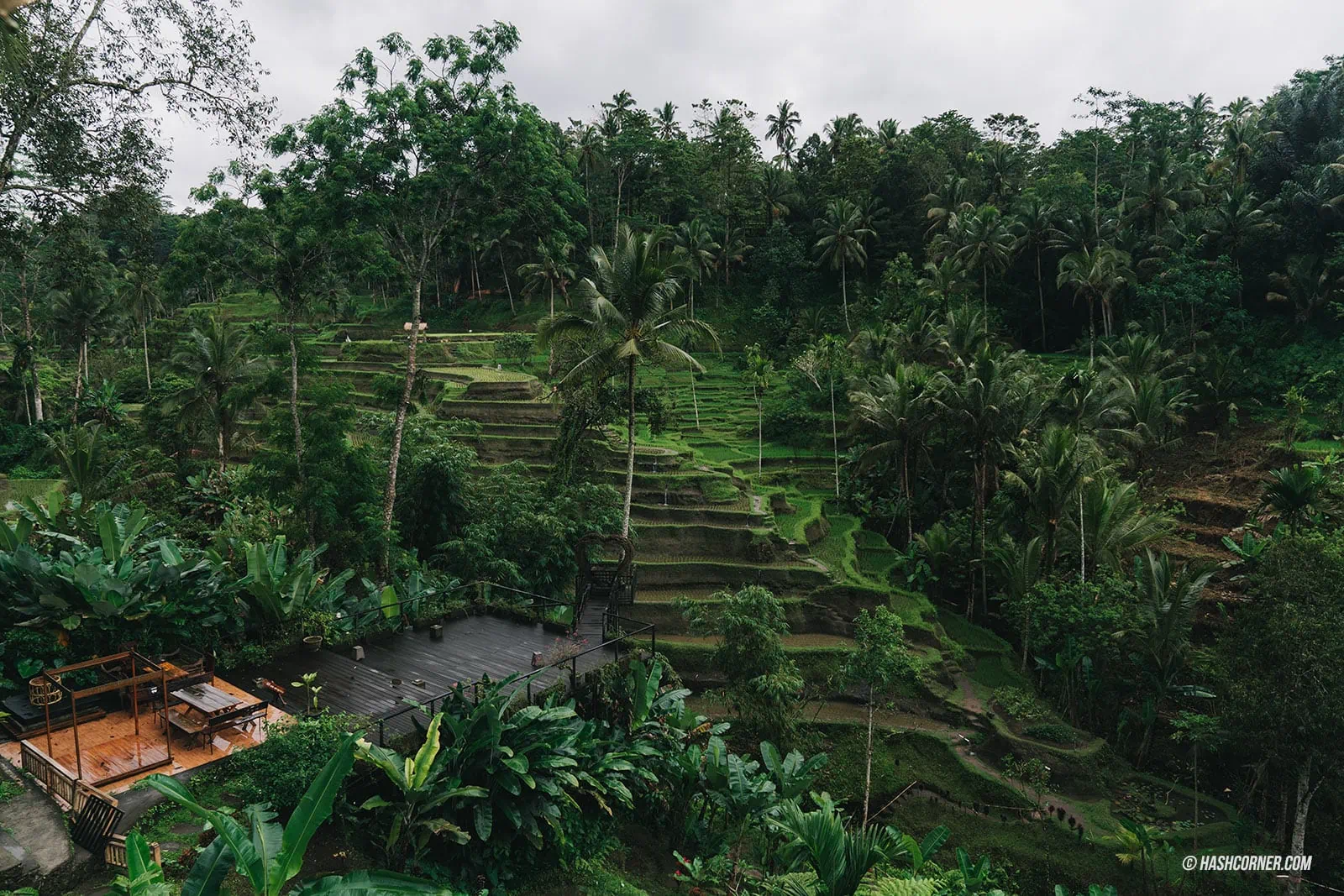
The atmosphere of this cafe was fantastic! Apart from the stunning view of the terraces, the restaurant was authentically Balinese, with a bamboo building and a swimming pool overlooking the scenic outdoors. Coupled with a vibrant green garden and a swing that juts out from the hillside, the whole setting was truly charming. No matter where you stand to take a photo, the place looks absolutely beautiful.


They offer a wide selection of food and drinks – from fusion dishes, Western cuisine, Asian food, to Indonesian meals. They also serve a variety of cocktails, fresh fruit shakes, and coffee. I ordered an Indonesian dish, spaghetti carbonara, and satay. Everything was absolutely delicious. The prices were reasonable, and you could easily order multiple dishes to share with friends.


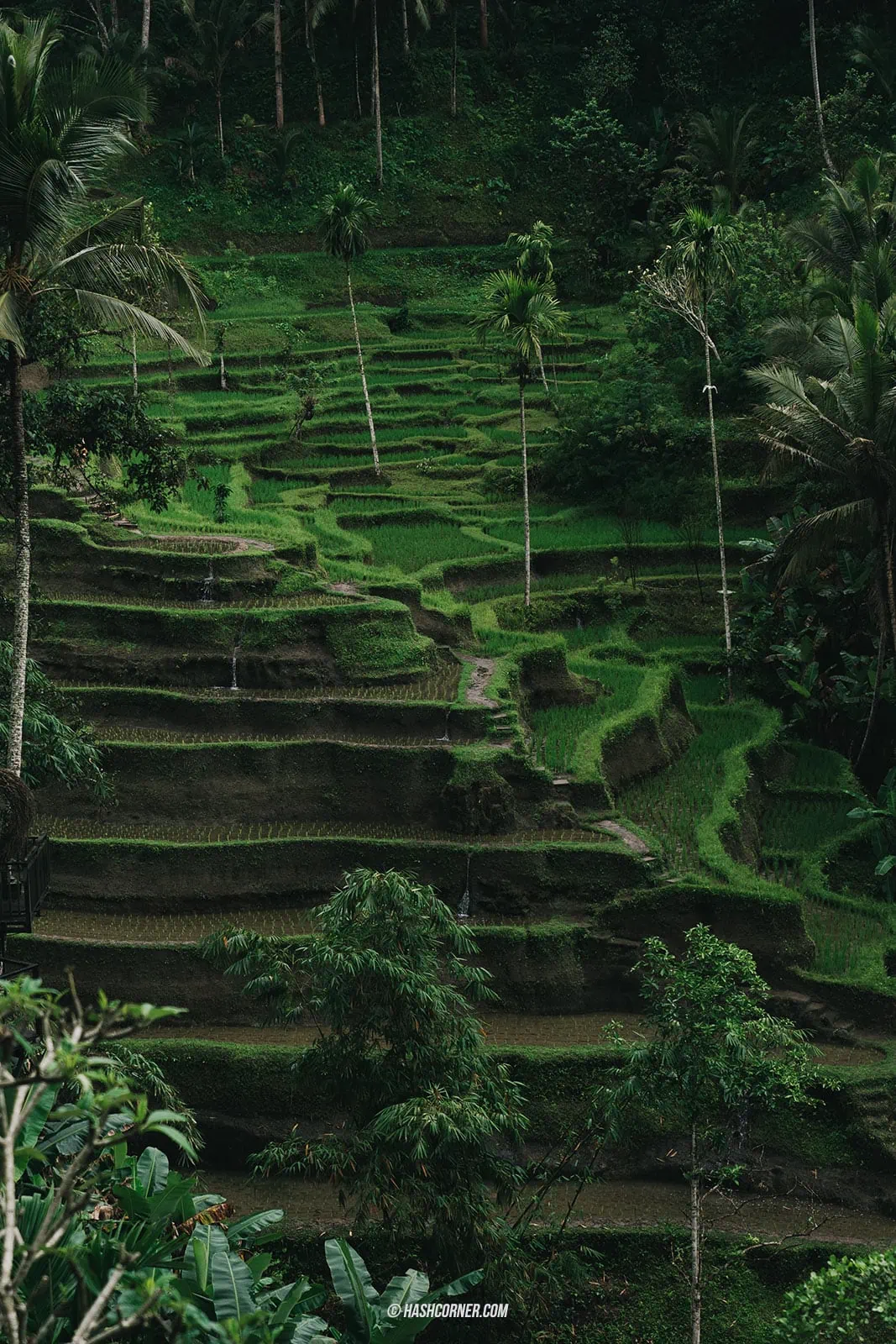

Overall, the TIS Restaurant is an amazing restaurant and cafe in Bali. If you’re visiting the Ubud region, I highly recommend this place. Not only is it a semi-cafe where you can enjoy the stunning view of the terraced rice fields, but it’s also a fantastic spot for those who want to chill, enjoy the breeze and take in the scenery. It truly feels like you’ve visited the terraced fields. Furthermore, if you’re a fan of taking photos, this place will impress you with its numerous picturesque spots – especially the swimming pool area embraced by the breathtaking view of the terraces and the natural greenery in the background. Add this place to your Ubud itinerary, and I guarantee you won’t be disappointed!

Pura Tirta Empul
Let’s continue our journey to Pura Tirta Empul, also known as the Temple of Holy Water among the tourists. This famous Balinese temple is renowned for its natural spring, believed to be sacred by local Hindus. The waters of the spring are thought to be as miraculous as holy water itself, prompting both locals and tourists to partake in purification rituals in the temple’s spring pool. The temple complex is magnificent, filled with quintessential Balinese artworks, stone carvings, and rituals that reflect the beliefs of the local community.
Pura Tirta Empul was established around a large spring during the Warmadewa Dynasty (10th-14th centuries). The temple is named after the spring, ‘Tirta Empul’, the source of the Pakerisan River. The temple consists of three main areas: the outer yard (Jaba Pura), the middle yard (Jaba Tengah), and the innermost yard (Jeroan). This temple was built in honor of Vishnu, a deity in Hinduism.

On my visit, I didn’t partake in the purification ritual in the holy spring, mainly due to not wanting to change clothes. Instead, I chose to observe how the locals and tourists performed their rituals. People lined up at points where the spring water flowed, prayed when their turn came, drank the water, washed their faces, and bathed. Anyone wanting to enter the spring pool will be asked right at the entrance of the temple. If you wish to participate, the temple provides necessary equipment, including lockers for safekeeping your belongings, and you won’t need to prepare anything yourself.


Beyond the holy spring, the inner area of the temple is filled with various Balinese-style buildings and familiar Balinese gateways. Here, local Balinese people come to worship, creating a strong, authentic Balinese ambiance that’s quite wonderful.


The temple complex also houses a large koi pond teeming with fish. If you’re interested, you can purchase food to feed the fish – there are some pretty big koi in there!
Personally, I consider Pura Tirta Empul one of the must-visit landmarks in Bali. If you’re planning a trip to Bali, this temple should definitely be on your itinerary. Apart from experiencing the sacred water spring, you’ll also get to witness local culture, beliefs, and practices firsthand. I’d say it’s one of the most worthwhile temples to visit in Bali.
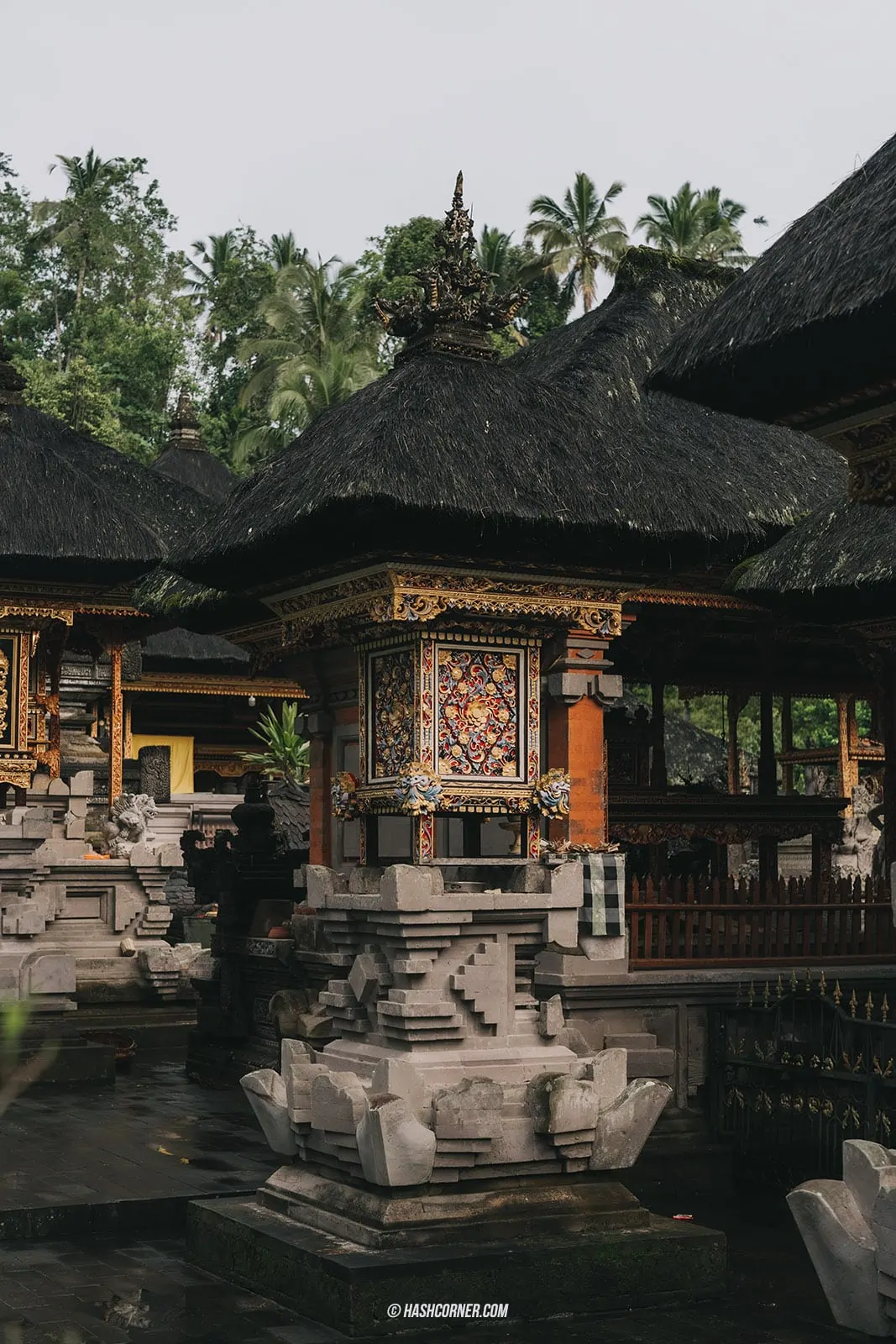



Day 2 in Bali:
Pura Ulun Danu Bratan
On the second day’s morning, I started my day by driving to the northern part of Bali, about 50 kilometers away, to visit the top-rated Pura Ulun Danu Bratan. This Hindu temple is one of the most significant and famous in Bali. The temple is located on the shores of Lake Bratan, surrounded by the lake and stunning mountain views, making the temple’s surroundings look like a gorgeous painting.
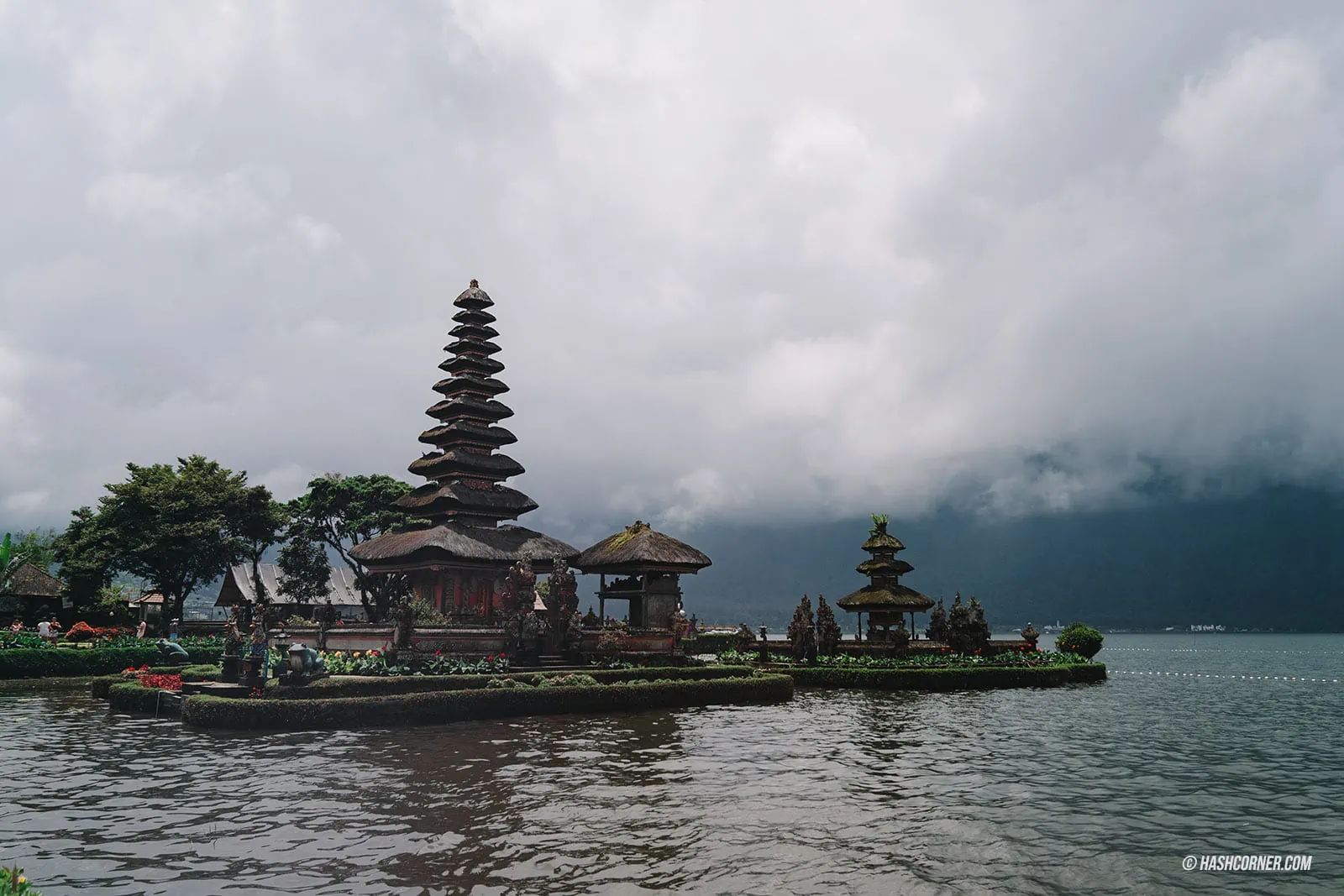
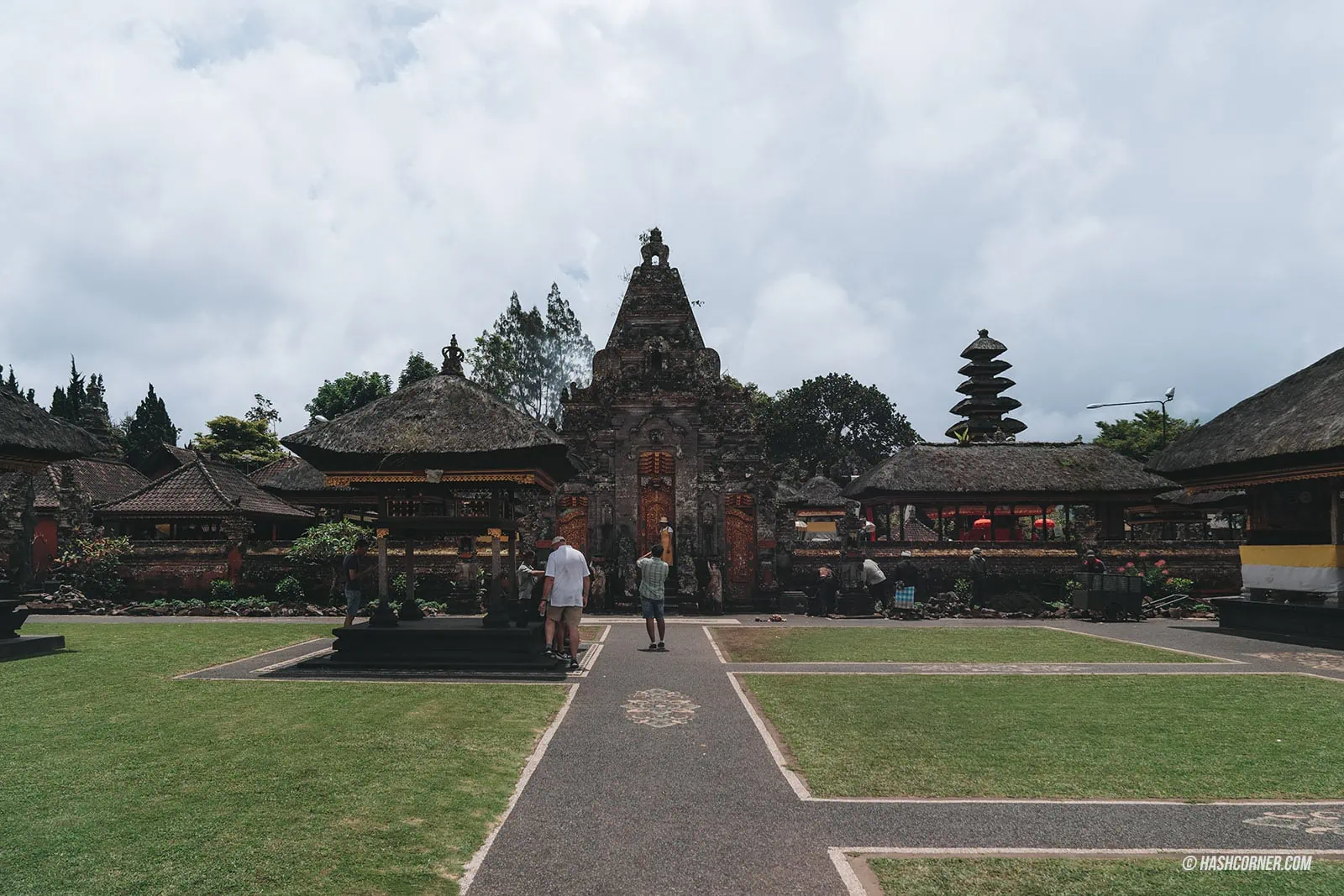
Pura Ulun Danu Bratan was built in 1633 to honor the goddess Danu, the water deity in Bali. The temple’s standout feature is its “Meru” or towering thatched-roof shrines, with 11 layers of thatch. These shrines, beautifully carved and decorated, sit majestically in the middle of the lake, becoming a popular spot for visitors to take photos. Some people refer to this place as “the Lake Temple of Bali” because it seems as if the temple is floating on Lake Bratan. The temple’s grandeur and significance can be judged by the fact that it’s even featured on the Indonesian 50,000 Rupiah banknote!

For those who visit here and want some stunning photos, I recommend renting a boat to take pictures on the lake, capturing the view of the water temple. I assure you that your photos will be as remarkable as those of famous Instagram celebrities!


For those who, like me, didn’t rent a boat, the best spot to take photos is from the shore, capturing the view of the shrine and the black crow of the lake. If you want to add a little something to your photo, try to find a spot with flowers and take a shot there. The result is incredibly beautiful and gives you the real Bali feel. If that’s not enough for you, I recommend walking along the lake. You’ll find a lane where the temple is nestled. This spot is also beautiful, giving you a raw Bali vibe.


In conclusion, Pura Ulun Danu Bratan is a famous temple that is as beautiful as the stories suggest. If you ask me if it’s worth a visit, I’d say anyone who visits Bali should make a trip up here. It’s a significant landmark. However, if you think coming here only to take photos with the shrine and spending almost a day like I did is not worth it, you may skip it. Bear in mind that it’s quite far and away from other tourist spots in Bali. So, think about it.


Leke Leke Waterfall
Leke Leke Waterfall is one of the most enchanting and Instagrammable spots in Bali. Nestled in the midst of towering cliffs and lush forests, the sight of this waterfall is truly breathtaking. You’ll want to see this stunner for yourself at least once, but getting there is a bit of an adventure!
If you’re driving there, just pin Leke Leke Waterfall on your Google Maps. But, be warned, you can only drive up to a small village along the way. The road beyond this village is pretty terrible – narrow and steep. So, you’ll have to park here and hire a local motorbike. They’re always on standby to ferry tourists to the waterfall. A motorbike can take only one person, and if I remember right, the cost is about 40,000 IDR per person.
The locals will zip you down another 3-4 kilometers to the entrance. Here, you’ll need to pay an entrance fee of 50,000 IDR. The motorbike guy will wait for you until you’re ready to leave. For the more adventurous souls who’re up for a motorbike ride around Bali, you can ride straight up to the entrance. Trust me, I’ve seen many tourists do it!

Once you’ve paid your entrance fee, you’re not quite there yet. There’s a 20-minute walk through a vibrant forest before you finally see the waterfall. The path is pretty easy, with some ups and downs and a small bridge crossing over a stream. But, overall, it’s well-made, so you won’t lose your way. Plus, the closer you get, the louder the sound of the waterfall. It’s a great little adventure, trust me!


I have to tell you, the first time I laid my eyes on the Leke Leke Waterfall, it was a wow moment! The atmosphere is simply magical, with the waterfall cascading down the cliff and splashing into a large pool, surrounded by mossy rocks and vibrant greenery. Once you see it, you totally understand why people go through all the trouble to visit and take photos.

I was lucky enough that there weren’t many people when I arrived, so I managed to take quite a lot of beautiful photos. But after I had my photo session, more tourists started to show up in groups. However, everyone was pretty orderly, lining up to take their shots with the waterfall in the background. If you’re thinking of dipping in the water, it might be a bit tricky because you’ll end up in someone else’s photo frame, which is probably why I didn’t see many people doing it. Most folks were there primarily for the photo ops.




In a nutshell, Leke Leke Waterfall is another stunning beauty that leaves a lasting impression. It feels like a hidden treasure tucked away in the mountains, waiting to be discovered. The lush and moist surroundings and the waterfall flowing down the length of the cliff is simply spectacular, making for incredible photos. If you’re up for a bit of adventure and fancy some stunning photos, I highly recommend it. After a day at the waterfall, that concluded my second day in Bali. This trip was all about exploring, as most places I visited were quite a distance from each other. It was truly an adventure!

Day 3 in Bali:
Batu Karu Kopi
Start your day on a fresh note at Batu Karu Kopi, one of the most renowned cafes in the Jatiluwih Rice Terraces region. Nestled halfway up Batukaru Mountain at an altitude of 2,700 meters, the cafe offers spectacular views. You can enjoy the lush green panoramic vistas of the Jatiluwih Rice Terraces stretching out as far as your eyes can see. What’s more, the surrounding area is teeming with over 50 varieties of tropical fruits and vegetables that are harvested year-round.
Before you head for Batu Karu Kopi, bear in mind that it’s located in the Jatiluwih Rice Terraces region, and you’ll need to pay an entrance fee to get to the cafe. But trust me, if you’re already planning to visit the terraces, it’s worth taking the time to stop by this cafe – it’s absolutely fantastic.

Like me, you might choose to stop by the cafe for a recharge before exploring the terraces. The ambiance of Batu Karu Kopi is truly invigorating. It’s an open-air cafe styled in a Balinese theme with wooden furniture, tables, chairs, and even the roof and pillars. Its elevated location allows the breeze to flow freely, making the cafe a relaxing spot to unwind. From here, you can enjoy a panoramic view of the terraces. The seamless integration of the cafe with its natural surroundings is so picturesque that you’ll swear you’re in a million-dollar-view cafe!

What makes this place special is their Specialty Coffee that sets it apart from typical cafes in Bali. They’ve meticulously selected high-quality coffee beans to create a unique beverage menu. At Batu Karu Kopi, they’ve ingeniously incorporated local Balinese sweets into their coffee menu. I tried one, but honestly, I couldn’t remember the name! However, I do remember how delicious it was – a robust coffee topped with local sweets, providing a perfectly balanced flavor. Additionally, I also got to try their local version of pizza, the Sourdough Pancakes priced at 50,000 Rupiah (~$3.5). It’s a large piece of sourdough bread baked with berries, infused fruits, and sugar – a delightful blend of tangy and sweet, served with a rich, sweet sauce. It’s an excellent pairing, I must say.
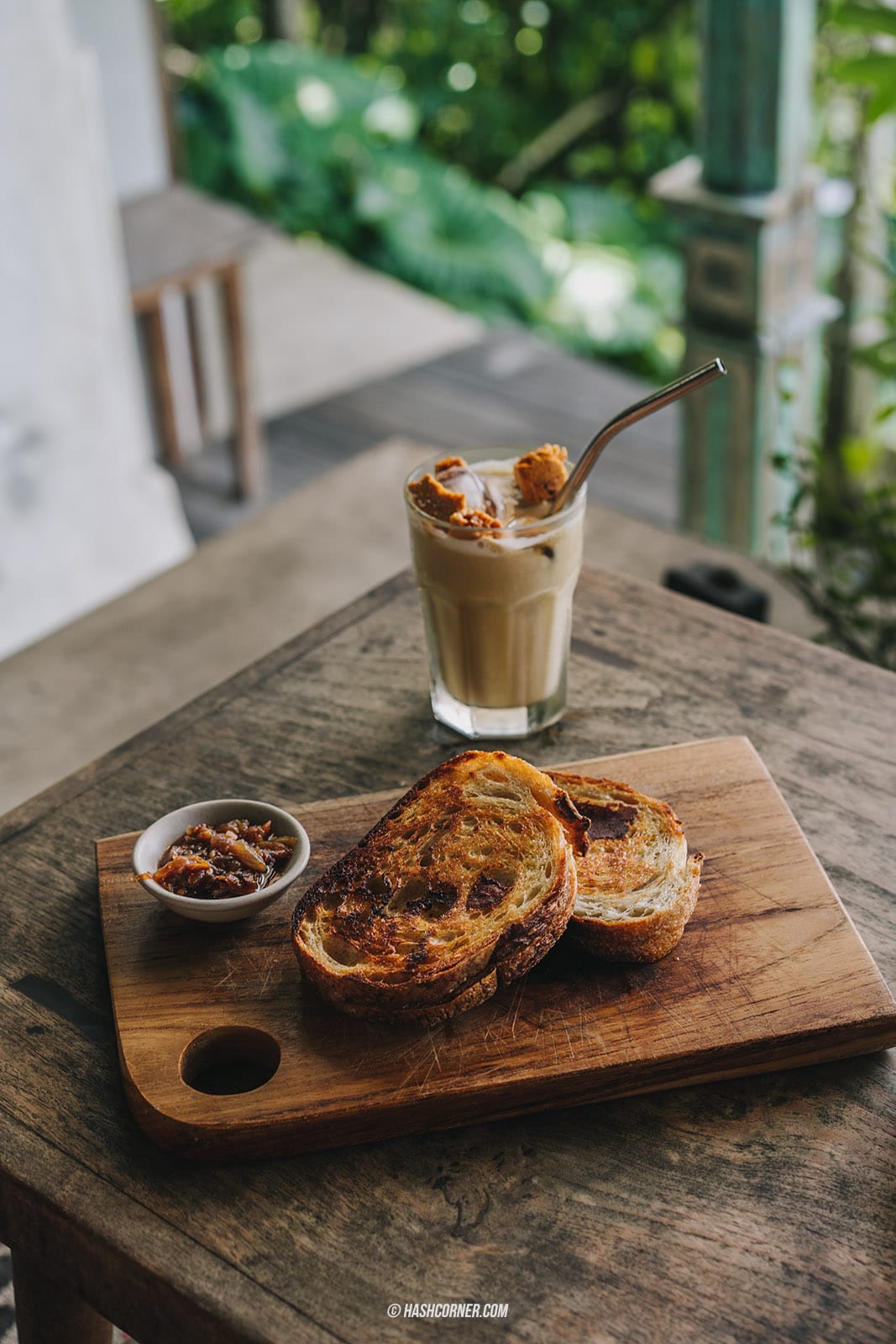



For me, Batu Karu Kopi is a cozy and unpretentious cafe with a great atmosphere, a beautiful mood, and an excellent spot to enjoy the lush view of the terraces. It’s a perfect warm-up stop to refresh and find something to drink before exploring the Jatiluwih Rice Terraces. Trust me, it’s worth a visit!


Jatiluwih Rice Terraces
After the café, it’s time for us to visit the Jatiluwih Rice Terraces, one of the largest and most beautiful terraces in Bali. So beautiful, in fact, that it’s recognized by UNESCO as a World Heritage Site. These stunning green step-like rice fields stretch across the Batukaru mountain range in Indonesia, situated about 700 meters above sea level in the village of Jatiluwih. Here, over 70% of the area is made up of these terraces, growing a local variety of rice known for its tall, sturdy stalks and beautiful grains.
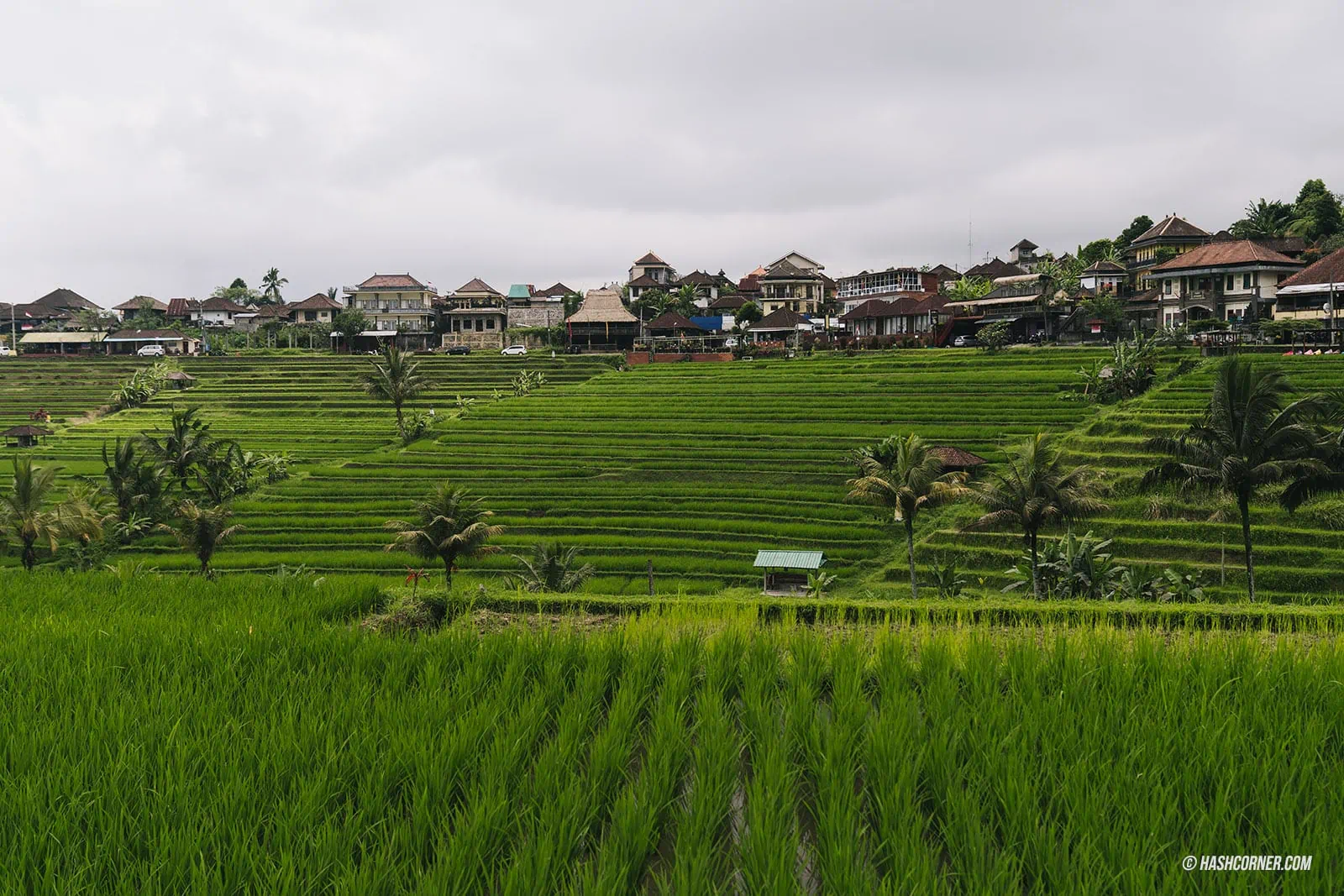

To visit the Jatiluwih Rice Terraces, the entrance fee is 40,000 IDR per person and 5,000 IDR per car. What makes the visit even more enjoyable are the five different hiking routes across the terraces, each of different lengths. They are color-coded: red for the short track (1.5 km, about 45 minutes), purple and yellow for the medium tracks (2 km and 2.3 km, about 1 to 2 hours), blue for the long track (3.1 km, about 1.5 to 2 hours), and white for the extra track (5.5 km, about 3.5 to 4 hours). Choose whatever fits your schedule and convenience!
I personally chose the purple path, which shares the same initial route as the red before veering off towards another side of the terraces. If you’re short on time, I’d recommend the red track as it still offers many highlights of this place.


Let me tell you, the tourists here are often awe-struck by the terraced fields. For me as a Thai, who see rice fields quite often in my country, this place still offers something special. The terraces are structured across hilly terrain, creating a landscape vastly different from the flat fields in Thailand. The lush green hues are soothing to the eyes and, amidst all this, you can observe the traditional Balinese lifestyle with their buffalo-herding, and quaint huts for resting from work. There are even small local shops selling refreshing beverages along the paths. Imagine sipping a cool smoothie amidst such incredible scenery. It’s a full-on ten out of ten!




All in all, if you’re looking for grand rice terraces that are even more impressive than the Tegalalang Rice Terrace, I highly recommend Jatiluwih Rice Terraces. This place is so picturesque that it feels surreal. Not only does it offer stunning views, but you also get to witness the unique lifestyle of the locals. The varying walking trails are an added bonus for explorers. If you wish to immerse in slow, peaceful, truly Balinese vibes, take the 5 km trail. Go all in! You won’t regret it!

Tanah Lot
Our last stop of the day is the renowned Tanah Lot Temple, located on the western coast of Bali. The temple premises sit on a promontory that stretches into the sea, crowned by a large rock that hosts the Tanah Lot Temple itself. The temple is hugely famous, especially for its picturesque scenery when the sea tides are high, making it appear as though the temple is located on a small island amidst the beautiful sea.
Just a short walk away, around 100 meters, is the Batu Bolong Temple, perched on the edge of a cliff. This area around the temples is vast, and I’m excited to take you on a journey exploring each point of interest.
Let’s begin with the Batu Bolong Temple. This temple sits atop a high cliff on the northern part of the Tanah Lot Temple compound, and you can walk right up to it. Locals believe this temple was erected to pay tribute to the divine. The atmosphere here is peaceful and serene, with a traditional Balinese gate marking the entrance, and inside, you’ll find a building that resembles a sanctuary. From here, you get breathtaking views of the sea – it’s an absolute treat for your eyes.
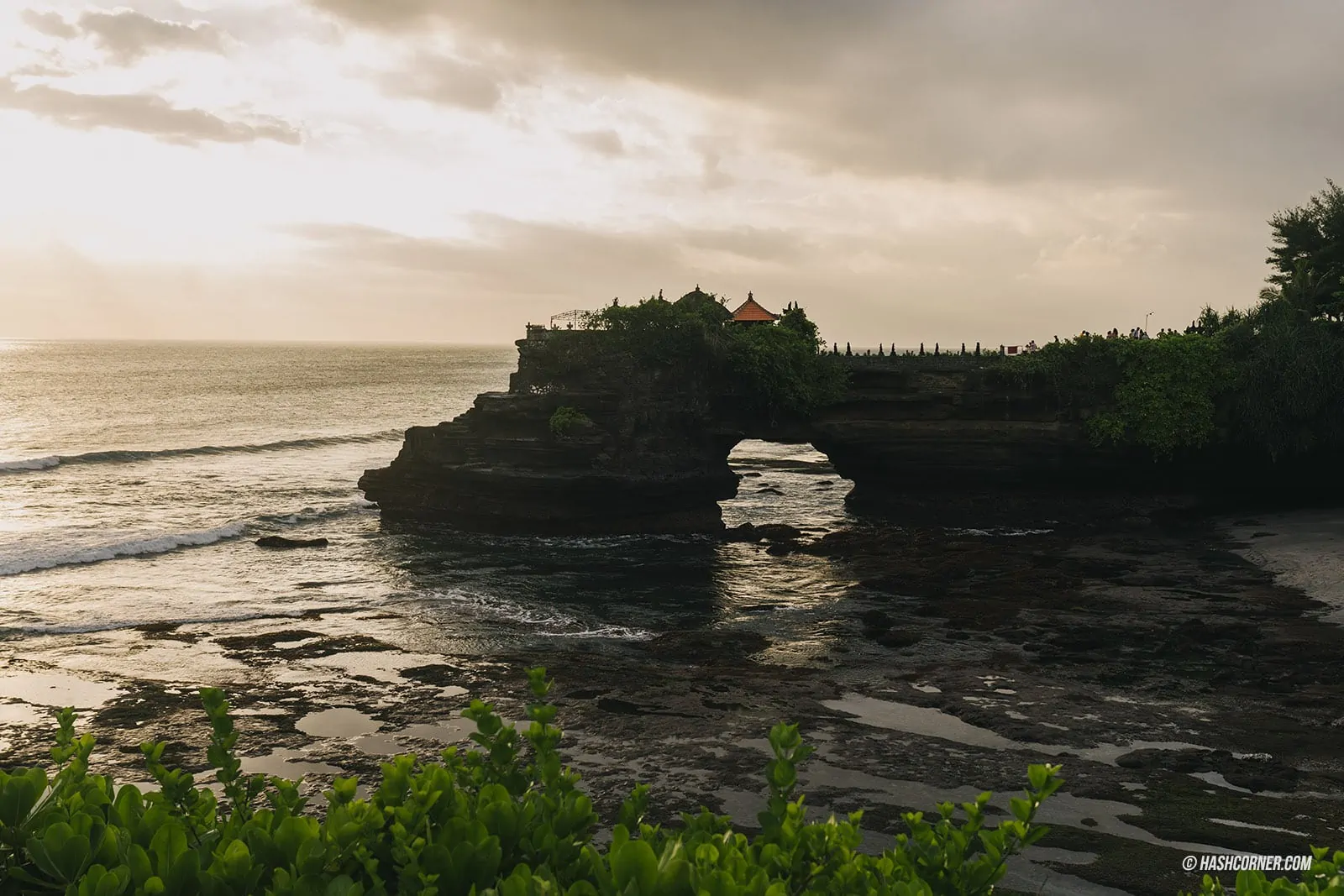
Tourists often flock to the Batu Bolong Temple for photo ops, and it’s not just the gorgeous views that draw them in. One of the temple’s unique features is the large base supporting it, made from a massive rock that has a large hole as if the stone has been pierced through, hence the name Batu Bolong or ‘Rock with a hole’. This hole is a natural occurrence caused by the constant erosion from the sea waves crashing against the rock. Over time, it caused part of the rock to collapse, creating this hollow space. This area is an excellent spot for photography, especially during sunset, when the setting sun casts its rays through the hole underneath the rock and strikes the sea waves. The resulting spectacle is absolutely divine, like a scene from a paradise on earth. You won’t want to miss it!



After exploring the charming Batu Bolong Temple and immersing ourselves in the majestic scenery, we cross over to our next destination: Tanah Lot, one of Bali’s seven sea temples. Regarded as a significant cultural symbol of Bali, Tanah Lot is not only an important religious site but also one of the most stunning places to enjoy a sunset view in Bali.
Tanah Lot was constructed by Dang Hyang Nirartha, a revered religious figure in Bali and a Hindu traveler, back in the 16th century. As he traveled along the southern coast of Bali, he came upon this beautiful rock island and deemed it a holy place. He ordered a shrine to be built on the rock to worship Dewa Baruna or Bhatara Segara, the sea god, resulting in the creation of Tanah Lot. Today, Dang Hyang Nirartha is also worshipped in this temple.

I must tell you something interesting, though. Over one-third of the entire rock island we see today is made of artificial stone! The reason is, part of the cliff face in the temple collapsed in 1980, and other areas of the island started deteriorating over time. In response, the Japanese government lent over $130 million to the Indonesian government to fund the reconstruction of the surrounding area. They meticulously blended artificial stone with the original, and to be honest, it’s challenging to distinguish between what’s real and what’s synthetic – it blends so seamlessly!

During my visit to Tanah Lot, I decided to go in the evening to witness the beautiful sunset and explore the rock base surrounding the temple. In the evening, when the tide is low, you can actually walk down to the base. The exposed rock base, appearing like a giant wok, is surrounded by high cliffs, the site of the temple itself. But I should warn you, during high tide, avoid descending to the base as the entire area is filled with sea water and crashing waves. At these times, Tanah Lot gives off an illusion of being a floating island in the sea – a sight to behold!

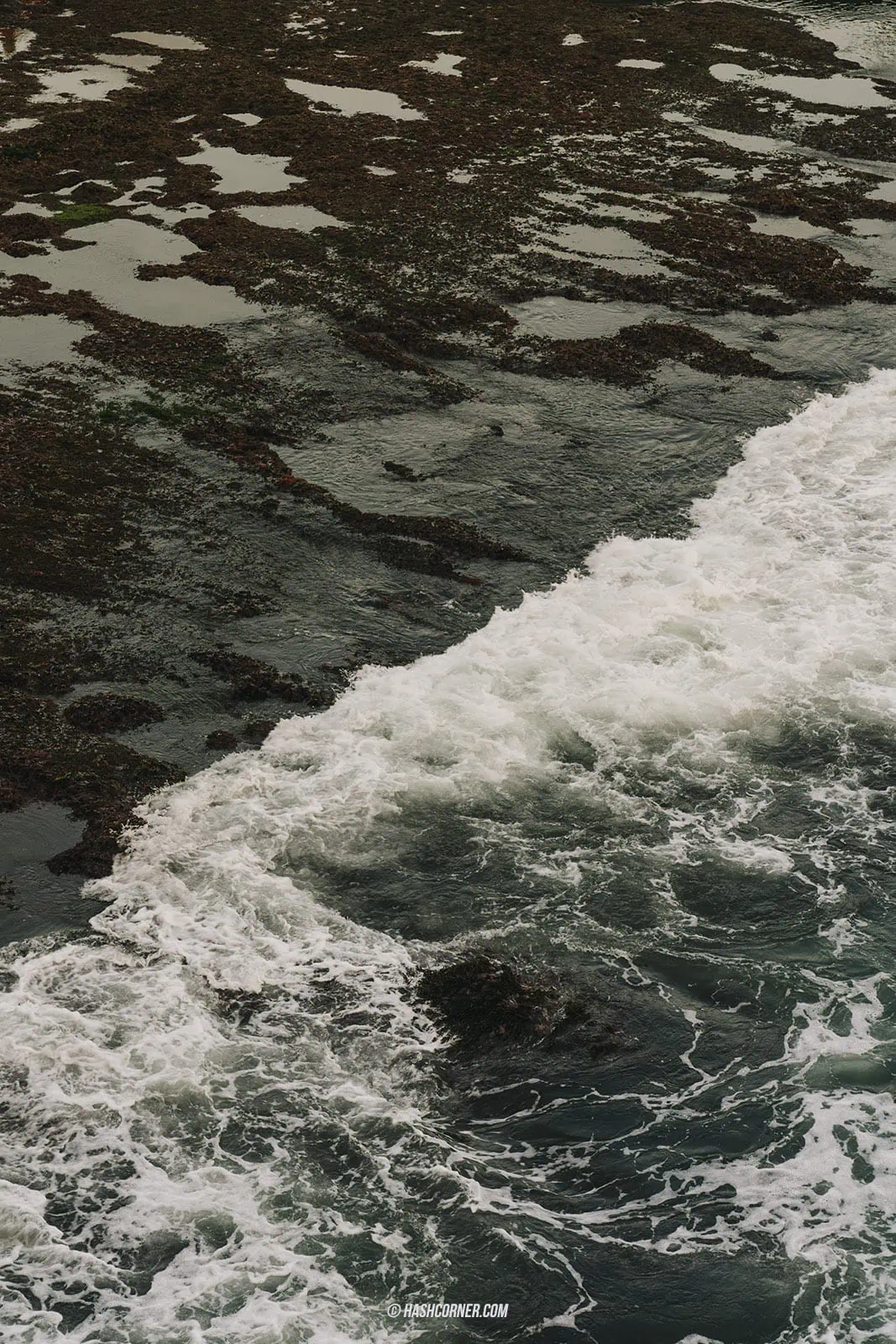
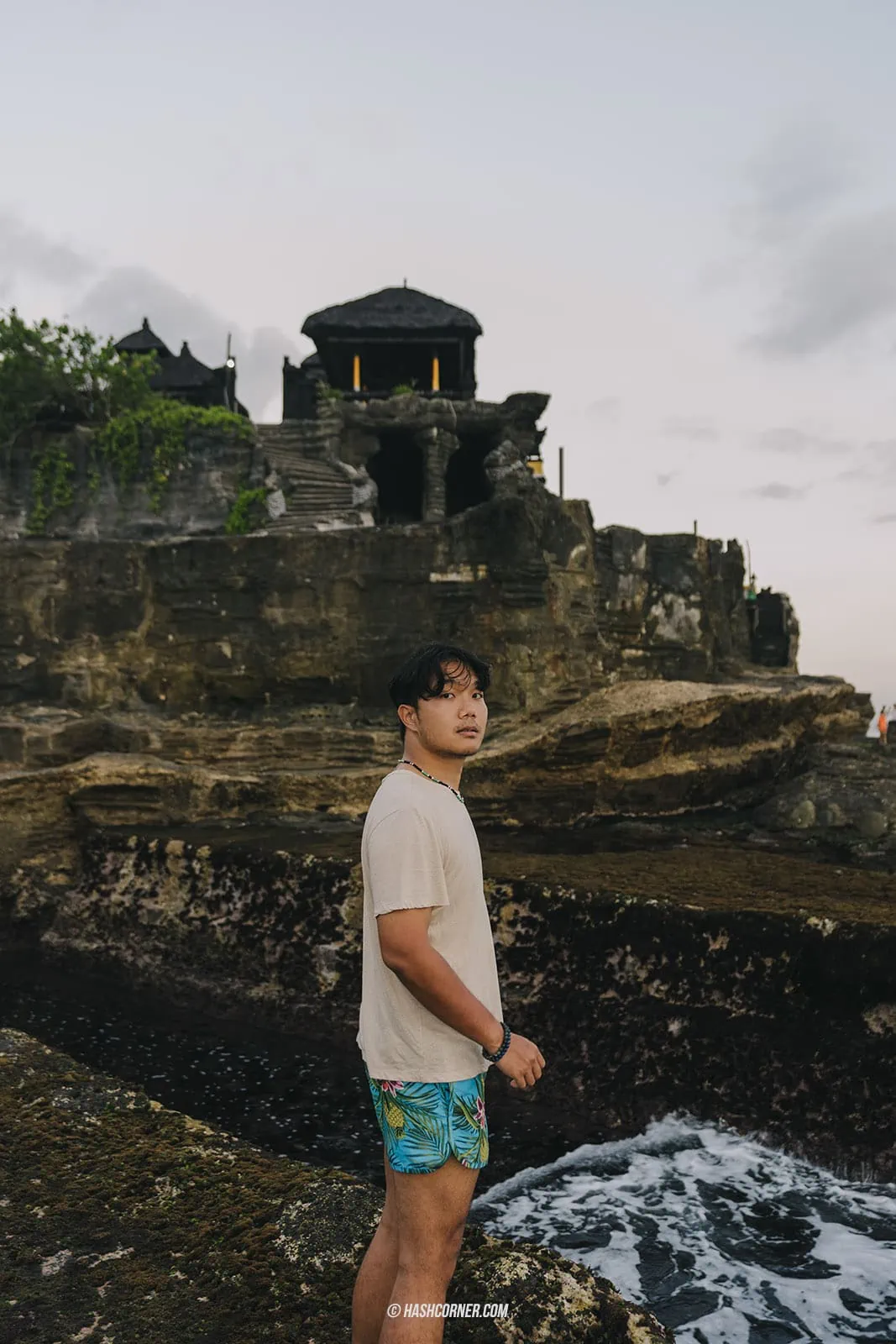

I spent a leisurely time at the temple, waiting until sunset. This place draws in many tourists mainly for its famed sunset views. It’s said that Tanah Lot offers one of the most splendid sunset views in Bali. I found a comfortable spot and settled down, breathing in the sea breeze, soaking in the salty sea air, surrounded by the day’s last golden rays reflecting off the sea. It was truly priceless. My only regret was that the sky wasn’t very clear that day, so I didn’t get to see the sun dramatically sinking into the sea. But, hey, that’s an excellent reason for another visit, right? You have to see it for yourself!


Day 4 in Bali:
Suluban Beach
We kicked off day four with a visit to a place often called a surfers’ paradise, Suluban Beach. One of the most distinctive beaches in Bali, Suluban Beach is naturally hidden in limestone formations. To reach the beach, you need to navigate through narrow paths, which perfectly explains why it’s called Suluban, a Balinese word ‘mesulub’ meaning to bend over. This is a hint at the bending, crawling, and ducking you’ll need to do along the narrow trails through the rock formations. And believe me, it’s true!


What amplified the experience on that day was the tide, it was high, and the waves were hitting the rocks with an impressive force. People flock to this beach for a single reason: surfing. The waves at this beach are internationally recognized for surfing, featuring swells between 3 to 12 feet. So, if you’re a serious surfer, I’d recommend visiting between April and August, Bali’s dry season when the waves are at their best.

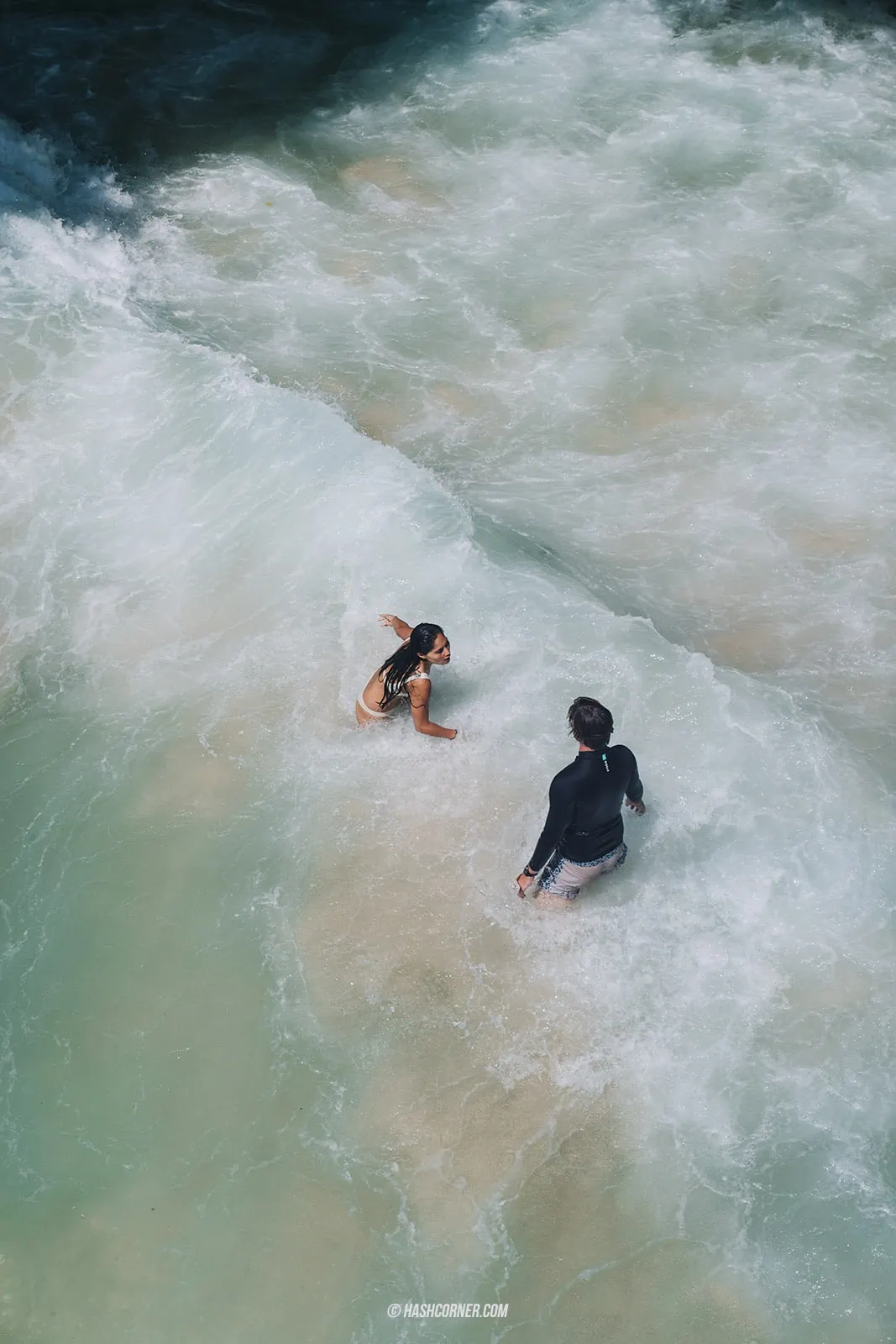

But if you’re like me, more into enjoying the views and the sea, the real thrill lies in exploring the various rock crevices that lead you to the beach. Especially when the tide is low, you can venture out further. If you fancy a freshwater dip after the sea or a place to relax away from the beach, there’s a pool up on the cliff at Suluban Beach, although it requires an entry fee.


Uluwatu Temple
Next, we went to Uluwatu Temple, one of the oldest Hindu temples in Bali, located atop a high cliff overlooking the breathtaking views of the Java Sea in the background. For those who are not satisfied with the sunset views at Tanah Lot Temple, I recommend you to continue to this place. It’s renowned as one of the most beautiful spots to witness a sunset in Bali.
The history of Uluwatu Temple dates back to the 11th century. It was built on a 70-meter (230 feet) high cliff protruding into the sea, dedicated to Sang Hyang Widhi Wasa, the supreme god of Indonesian Hinduism. Legend has it that the rock base of the temple is part of a ship that turned into stone. The locals believe that this temple serves to protect Bali from evil spirits.



After parking the car, I started walking along the hillside, surrounded by a soothing cool breeze. On one side, you get a broad view of the sea stretching as far as the eye can see. On the other, there’s a shore full of lush green trees against the clear blue sky. It’s a heartwarming mood that impresses right from the first step.
Although the atmosphere is delightful, I must warn you that the monkeys at this temple are quite audacious! The temple is a habitat for Macaca Fascicularis monkeys and numerous others, which are notoriously mischievous and love to snatch our belongings. If you’re carrying sunglasses, bags, drinks, or food, I suggest keeping them safe. These monkeys are professionals at thieving! They would swiftly snatch anything that catches their attention. To reclaim your stuff, you usually have to lure them with food in exchange. It’s astonishing how smart these monkeys are, learning the concept of bartering from observing human behaviors.



Inside the temple, you can leisurely admire the beauty of the architecture. There’s a three-tiered main building standing majestically on the cliff, with smaller structures scattered around. All the buildings are in traditional Balinese style. From the main temple, you can enjoy a panoramic view of the sea. Once you’ve enjoyed the views, you can walk out and follow the hillside to another area, which is a stage for performing Kecak Dance, a famous show at Uluwatu Temple. It’s performed every day at 6 pm and is undoubtedly one of the highlights of visiting this temple.
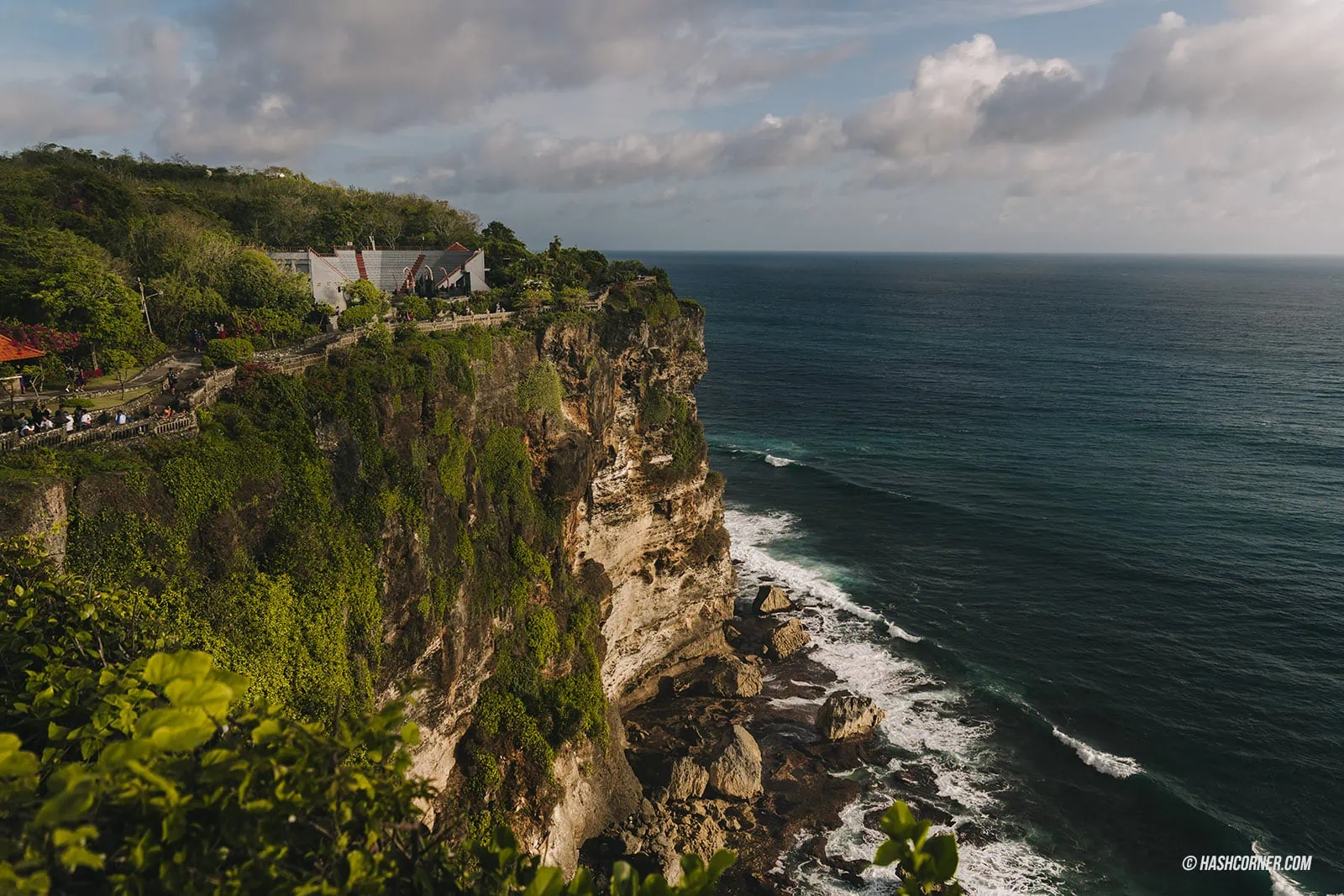
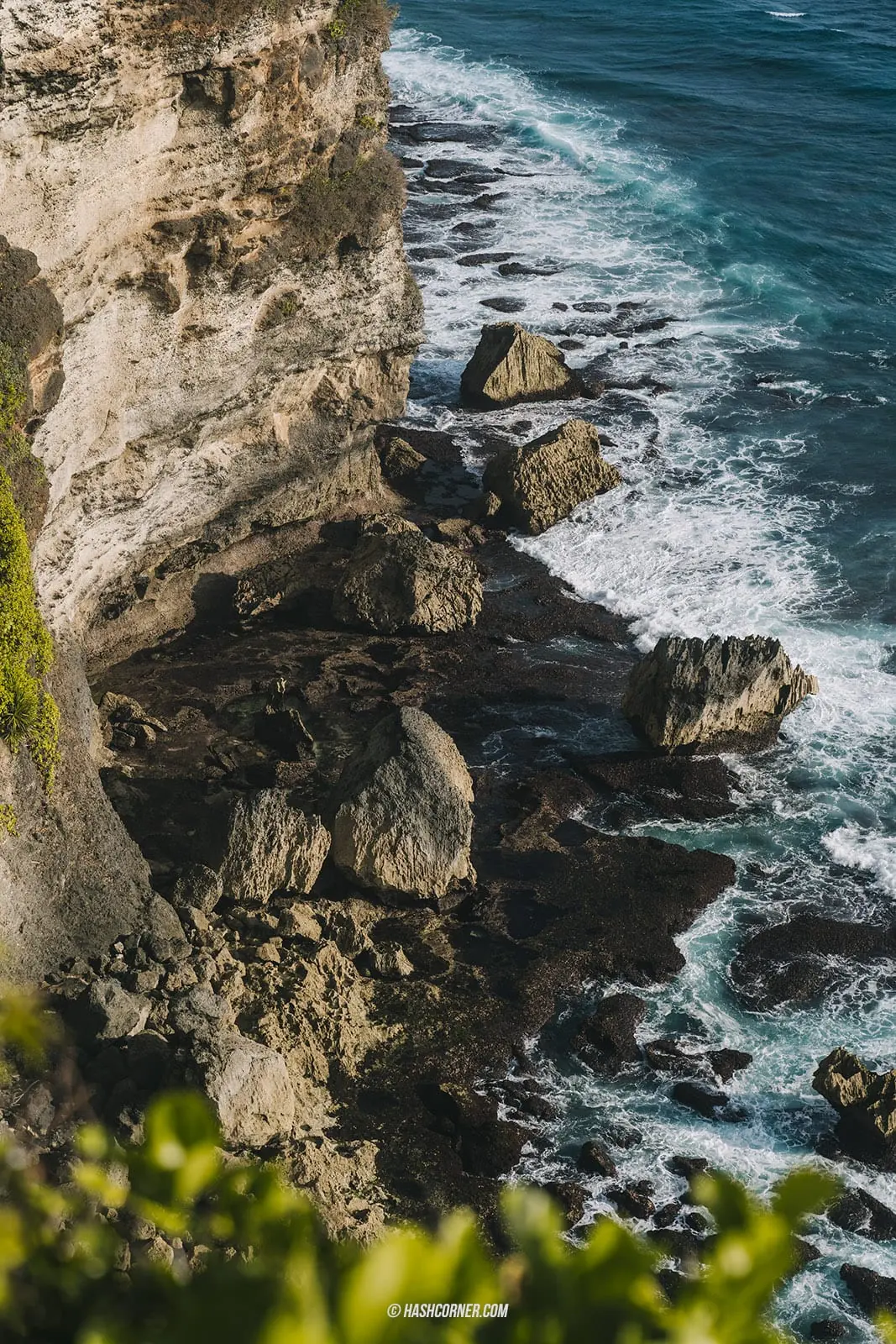

For sure, apart from wandering around the temple and enjoying its stunning views, your highlight was the Kecak Dance performance. You strongly recommend booking tickets through Klook in advance. The benefit of booking beforehand is that you can present your E-ticket at the entrance and get straight in without having to queue and buy a ticket, saving valuable time. You can see the photo below that many tourists queuing so long just to get a ticket. Therefore, for a smoother experience, booking in advance through Klook is indeed a great idea, click.

The Kecak Dance show is one of the most renowned performances in Bali, featuring more than 50 performers who act out a storyline from the Ramayana epic. This particular part of the story involves Lord Rama rallying a monkey army to rescue Sita on the island of Lanka. The performers, mostly men, sit on the ground, embodying the monkey army. They are dressed in black and white checkered cloths, red belts around their waists, and red hibiscus flowers tucked behind their ears, chanting rhythmically in place of musical accompaniment. The main characters like Rama and Sita also join in the performance.
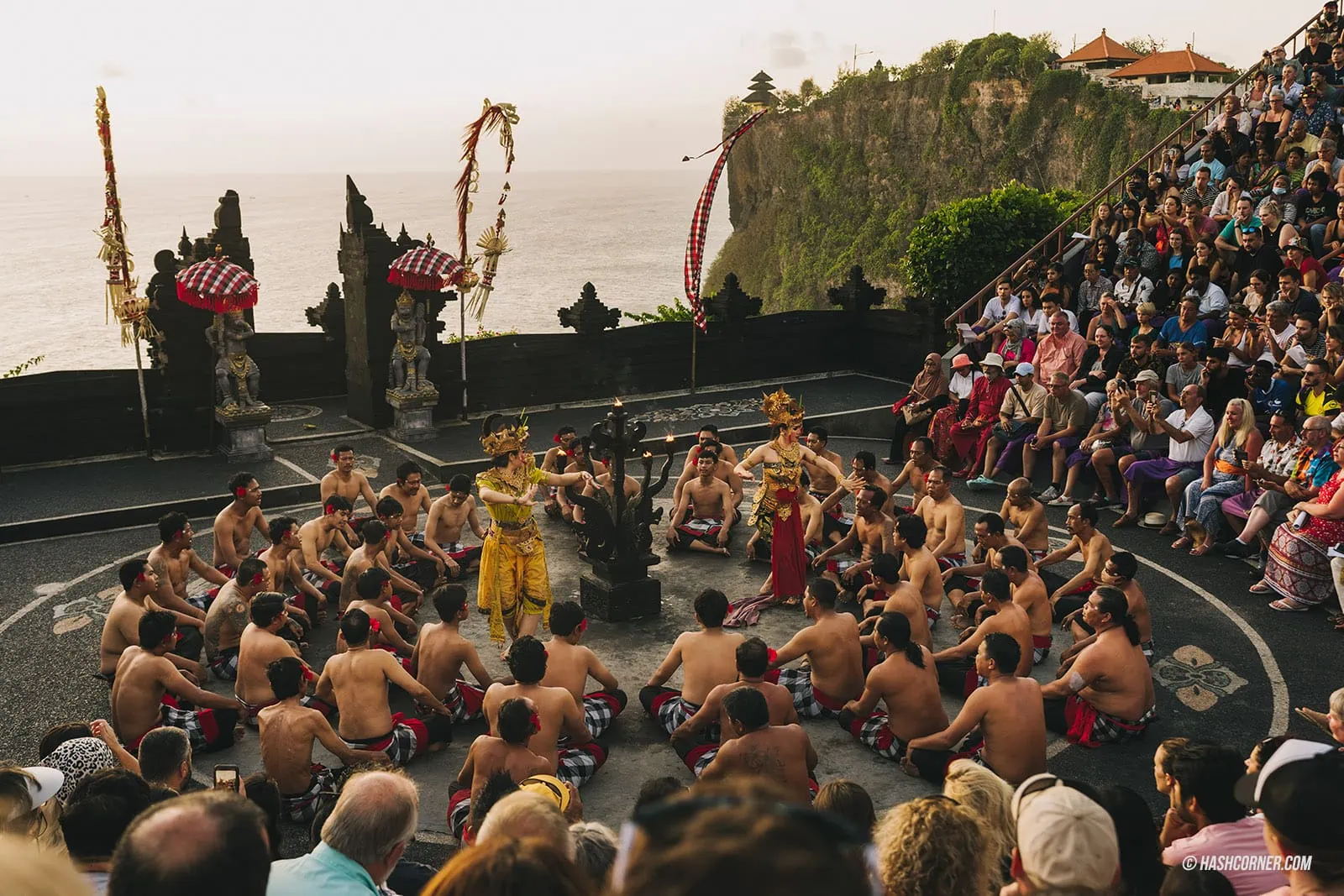
Before the show starts, they distribute pamphlets explaining the storyline because there’s no dialogue in the dance, and most of the audience, predominantly foreigners, are likely unfamiliar with the Ramayana epic. So, if you’re worried about not understanding the performance, make sure to read the pamphlet beforehand.
The hour-long show is a captivating spectacle with the energy from the rhythmical chants of 50 men reverberating around the open-air theatre, a powerful Rama with an intense makeup-clad face, ornate costume, and dramatic movements in search of Sita. The beautifully attired Sita moving gracefully adds another dimension to the performance. It’s a unique and thrilling experience that you won’t easily find elsewhere. It’s certainly worth a visit, at least once.

Moreover, while you’re engrossed in the dance, the sun begins to set perfectly, and you’re treated to a stunning sunset over the ocean. It’s truly a breathtaking sight that adds value to your ticket. In summary, you highly recommend visiting Uluwatu Temple. The temple itself is magnificent, the atmosphere is incredible, and the dance performance is totally worth it. You’re urging everyone to visit and experience it firsthand.
Days 5-6 in Bali:
Nusa Penida Island
For days 5 and 6 of your Bali trip, you took a little detour from the island of Bali to the stunning Nusa Penida. Nusa Penida, situated to the southeast of Bali, is an island that you absolutely shouldn’t miss when visiting Bali. The island’s landscape is dominated by mountains, resulting in a plethora of beautiful beaches and uniquely shaped cliffs. One of the most recognizable landmarks that you’ve probably seen often on Instagram is the T-Rex-shaped cliff, which is located right here on Nusa Penida. You have to admit, the natural beauty and the sea here are incredibly stunning.
For a comprehensive review of Nusa Penida Island, click here.
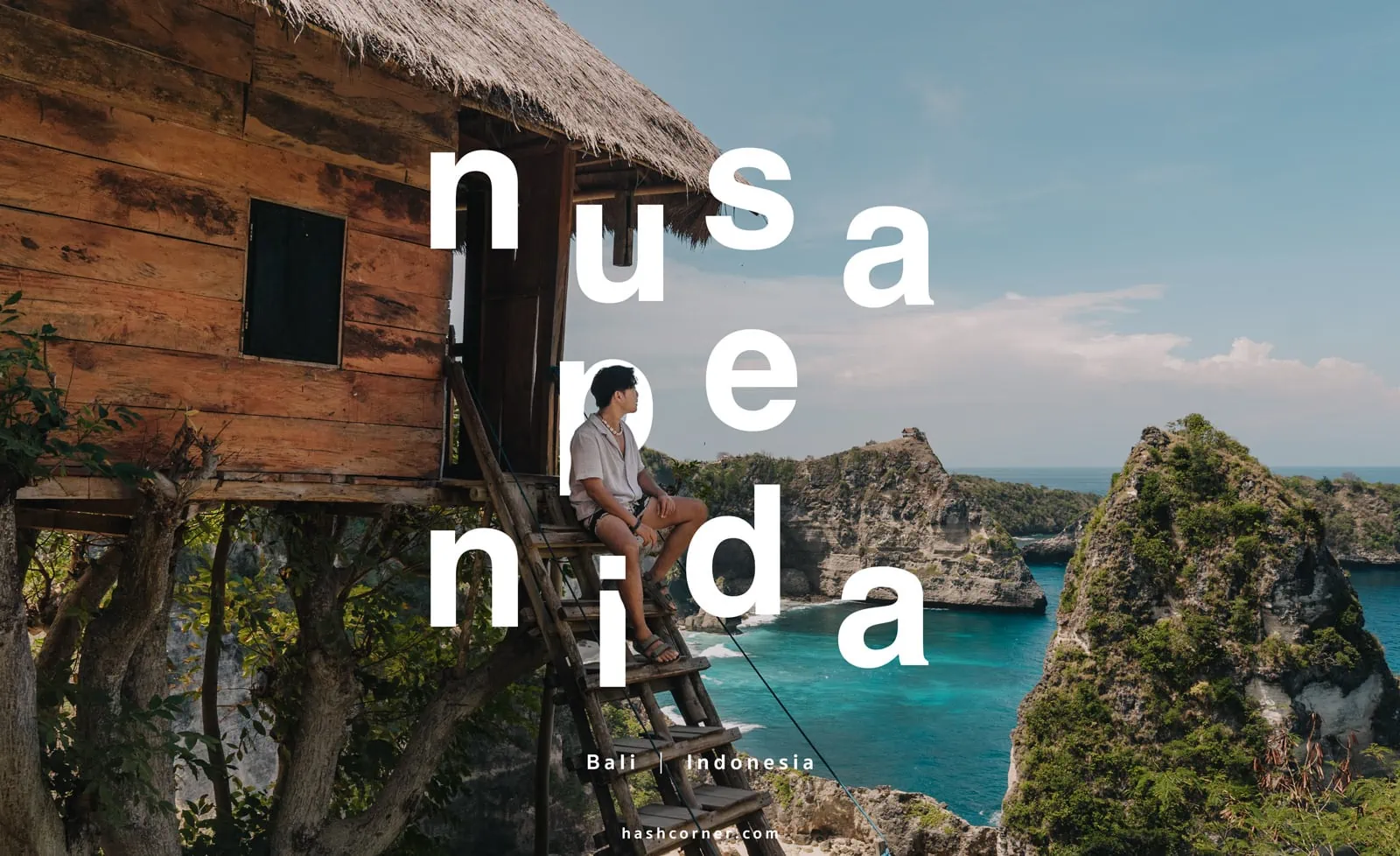
The Hotel I Stayed in Bali:
Ume Sri Villas
The first hotel I stayed at in Bali was Ume Sri Villas. If you’re into spacious and beautiful private pool villas, I wholeheartedly recommend Ume Sri Villas. Nestled in the Ubud district, it’s surrounded by vibrant green fields and provides all the necessary amenities. With an overall area of more than 80 square meters, you can get a villa for just $80 per night, including breakfast. It’s such a bargain, and you can hardly find a pool villa at this price in Thailand!
One of the advantages of Ume Sri Villas is its convenient location in Ubud, just 2 kilometers away from the Sacred Monkey Forest Sanctuary. It’s also easy to visit other tourist spots in Bali. They provide parking for guests (for a small additional fee), and apart from the prime location, Ume Sri Villas offer the utmost privacy. The walls of the pool villas are very high, so we can confidently assure that no one can see us while we’re swimming in the pool.

The atmosphere of the pool villa gives us the feeling of relaxing in a spacious, comfortable house because of the high roofs, which make the space feel open and airy. The interior is decorated in wooden tones, white, and accents of grey. It’s complete with all the amenities we need: a comfortable large bed, a long sofa for chilling, a refrigerator, air conditioning, a TV, and free Wi-Fi. But what I loved most was the large open-air bathroom styled in Bali’s tropical theme with cute flowering Dendrobium orchids and a skylight that allows natural light to fill the room. Of course, as a pool villa, it wouldn’t be complete without a swimming pool. At the front of the house is a small area where you can immerse yourself or swim leisurely.


For breakfast, we can choose either American-style or Indonesian cuisine. It’s not a buffet, but the food is delicious and filling. Overall, I was quite impressed with Ume Sri Villas. A pool villa costs less than $100 a night but offers everything—it’s like renting a comfortable house just to hang out. Even if we didn’t go anywhere, we could have a very relaxing time here.

The Saren
The Saren is another pool villa in Bali where we stayed. We booked one of the few pool villas available at this hotel. The atmosphere of The Saren is rather hip and a little romantic, especially in the pool villa. Moreover, it is not far from Tanah Lot Temple, which we can easily drive to. For those traveling in central-western Bali, you can stay here. In addition to the pool villa, they also have other room sizes to choose from. The pool villa we stayed in was booked for only $76 per night. It’s such a great deal, almost unbeatable in Thailand, which is my home country.

When you open the door to the pool villa, you are greeted by high walls filled with lush greenery, giving a fresh, verdant vibe right from the first step. Their pool villa is decorated in a bare concrete loft style with a touch of wood, providing a homey feel and a chic Bali vibe. What I love most about this place is the open and transparent room that lets in abundant natural light through large glass windows. Everywhere you look is picture perfect.
In terms of amenities, everything is complete: a comfortable king-size bed, fridge, air conditioning, you name it. The highlight here is the open bathroom. The bathtub and rain shower are centrally located with nothing in between. There’s a separate smaller room for the dry area. It’s very romantic if you’re staying with a partner. But if you’re with friends or parents, it might be a little awkward because the bathing area is behind the bed and there’s only a large transparent glass in between.
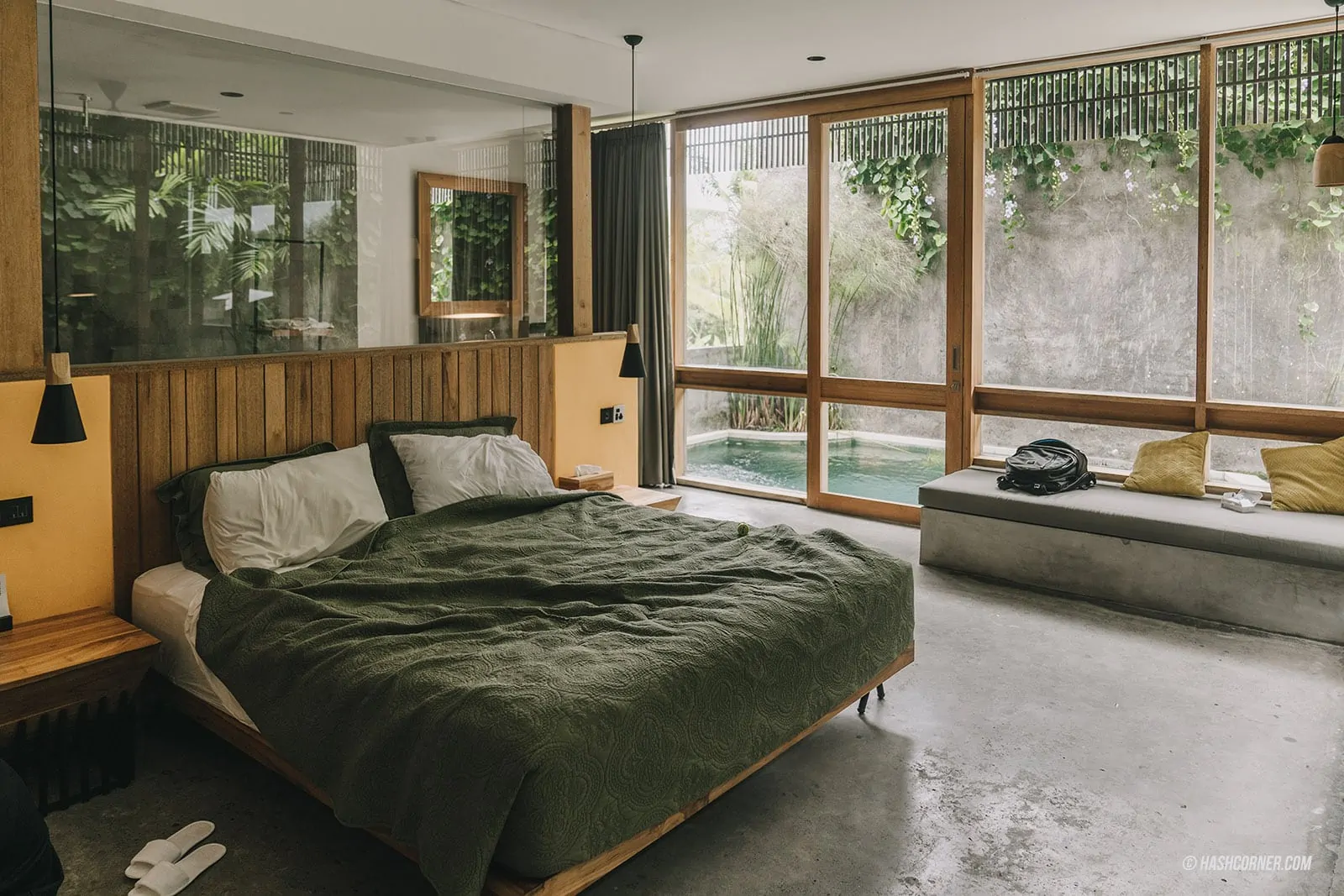



From the bedroom, you can open the door and go straight into your private swimming pool. The size of the pool is perfect for playing and soaking. The pool’s wall is not as high as the entrance wall, so you can see the view of the rice fields outside. It’s like a feel of swimming and admiring the fields. As for breakfast, they do not provide it. But there’s a café and restaurant in front of the accommodation. If you’re too lazy to go out, you can eat here. But you need to understand that the place allows outsiders to come in and eat and drink in the restaurant.

Overall, The Saren is an excellent accommodation. The pool villa is super romantic and perfect for couples. The atmosphere is peaceful and not crowded. As for the room where we stayed, it was comfortable as if we were relaxing amidst nature. Everything is great, except one thing: come alone or with a partner only. But if you want to come with friends, you can book their other standard-size rooms. Even if you don’t get to stay in a pool villa, they have a communal swimming pool for you to enjoy. It’s perfect, and most importantly, super value for money.
Sri Phala Resort & Villa
If you’re planning a trip to Nusa Penida island, I highly recommend securing accommodations near the port the night before your journey. It saves so much time traveling to the port! On the night before I set sail for Nusa Penida, I chose to stay at the Sri Phala Resort & Villa. It’s conveniently located within a casual walking distance from the Sanur beach port, which made it the perfect choice. I knew that come dawn, we could stroll down to board the boat without rushing.
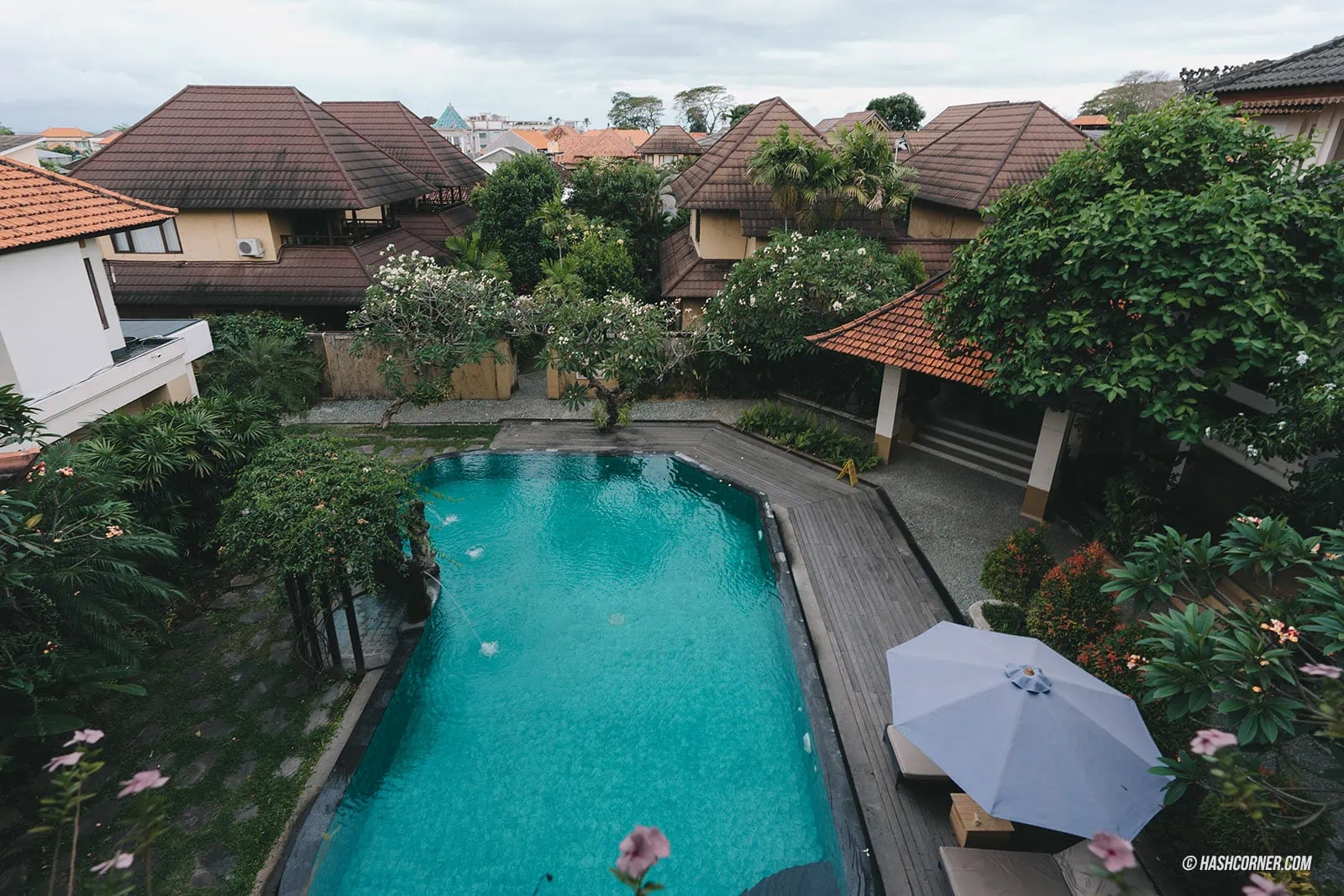
Sri Phala Resort & Villa is one of the great hotels around here, especially considering the reasonable pricing. It’s a comfortable place to stay, too. The spacious bed is the centerpiece of the room, which also includes all the amenities you could need. You’ve got your towels, refrigerator, television, and a private bathroom. Plus, there’s a table and chairs on the balcony where you can relax, enjoy the breeze, and soak in the chill vibes.

Overall, it’s a pretty great place – comfortable and conducive for a good night’s sleep. But the best part? Waking up in the morning and being able to just walk down to the port. On the eve of our departure, we informed the hotel reception that we would be leaving early in the morning. They prepared our breakfast box for us to take. Such a fantastic hotel! If you’re thinking of booking, don’t hesitate!
Bali Trip Summary
My 6-day, 5-night trip to Bali was yet another impressively memorable experience. The unique style, distinct culture, and vibrant arts of Bali were perceptible almost everywhere I went. And of course, we must acknowledge the natural beauty of Bali, which is second to none. Especially, the Bali sea – it’s mind-blowingly beautiful! The mesmerizing azure water against the backdrop of high-rolling waves is quintessentially Balinese. The scenic views at various tourist spots are awe-inspiring, and nature is abundant, scoring a full ten out of ten.
But there is one thing that’s a bit off-putting. The locals seem to be a bit too eager to extract money for almost everything. At times, it felt somewhat… excessive. However, most of the locals are genuinely lovely people.
Well, if you’re planning to follow my footsteps to Bali, don’t overthink it. Come and experience the authentic ambiance for yourself. It looks good in pictures, but I promise, it’s 300% better in person. Lastly, to everyone who has read my review and plans to visit Bali, I wish you a joyful and exciting trip! Enjoy every moment of it, folks!
ส่วนลดจองโรงแรมจาก Agoda, Expedia, Booking และบัตรสวนสนุก ตั๋วรถไฟ กิจกรรมท่องเที่ยวจาก Klook และ KKday ปี 2023
⚡️ สำหรับใครที่กำลังจะจองที่พักและหาส่วนลดจองโรงแรมอยู่ ลองดูตามลิงค์ด้านล่างได้เลย มีทั้ง Agoda, Expedia, Booking รวมถึง Hotels.com ด้วย ประหยัดไปได้อีกเกือบ 10-20% ใช้ได้กับโรงแรมทั่วโลก
หลายคนอาจจะไม่รู้ว่าเว็บไซต์จองโรงแรมพวกนี้ มีส่วนลดท็อปอัพจากบัตรเครดิตเพิ่มเกือบทุกธนาคาร ไม่ว่าจะเป็นบัตรเครดิต Citibank, KBANK, SCB, Krungsri, KTC, Bangkok Bank, UOB และ TMB หรือแม้แต่ส่วนลดจากค่ายมือถืออย่าง AIS, DTAC หรือ True ซึ่งส่วนลดพวกนี้จะเปลี่ยนตลอดทุกเดือน และเก๊าก็อัพเดทให้ตลอดเวลาเน้อ 🧡





